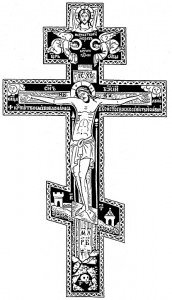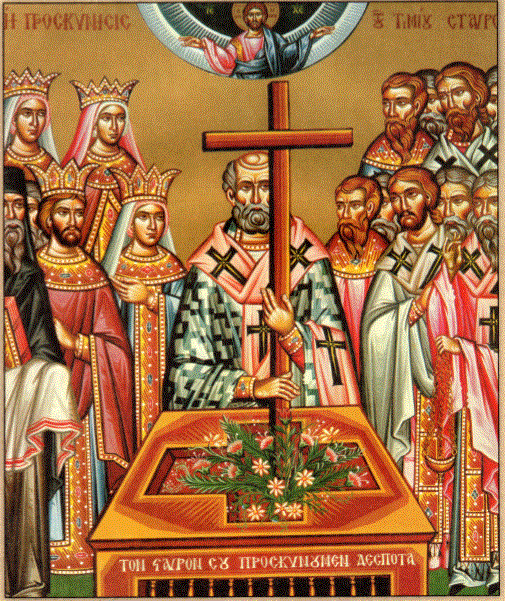|
Twenty-Seventh Week After Pentecost 12/4/2017 to 12/11/2017 |
|
|
Monday 12/4/2017 |
1 Timothy 5:1-10 Luke 17:20-25 |
|
Tuesday |
1 Timothy 5:11-21 Luke 17:26-37 (& 18:8) |
|
Wednesday |
1 Timothy 5:22-6:11 Luke 18:15-17, 26-30 |
|
Thursday |
1 Timothy 6:17-21 Luke 18:31-34 |
|
Friday |
2 Timothy 1:1,2,8-18 Luke 19:12-28 |
|
Saturday |
Galatians 5:22-6:2 Luke 10:19-21 |
|
Twenty-Seventh Sunday After Pentecost |
Matins: Luke 24:12-35 (Matins Gospel 5) Liturgy: Ephesians 6:10-17 Luke 13:10-17 (Slavs), Luke 18:18-27 (Greeks) |
|
Twenty-Sixth Week After Pentecost 11/27/2017 to 12/10/2017 |
|
|
Monday |
1 Timothy 1:1-7 Luke 14:12-15 |
|
Tuesday |
1 Timothy 1:8-14 Luke 14:25-35 |
|
Wednesday |
1 Timothy 1:18-20; 2:8-15 Luke 15:1-10 |
|
Thursday |
1 Timothy 3:1-13 Luke 16:1-9 |
|
Friday |
1 Timothy 4:4-8, 16 Luke 16:15-18, 17:1-4 |
|
Saturday |
Galatians 3:8-12 Luke 9:57-62 |
|
Twenty-Sixth Sunday After Pentecost |
Matins: Luke 24:1-12 (Matins Gospel 4) Liturgy: Ephesians 5:9-19 Luke 12:16-21 |
November 26, 2017
Twenty-Fifth Sunday After Pentecost
– Matins: Mark 16:9-20 (Gospel 3)
– Liturgy: Ephesians 4:1-6, Luke 13:10-17 (Slavs), Luke 18:18-27 (Greeks)
|
Twenty-Fourth Week After Pentecost |
|
|
Monday |
1 Thessalonians 2:20-3:8 Luke 11:29-33 |
|
Tuesday |
1 Thessalonians 3:9-13 Luke 11:34-41 |
|
Wednesday |
1 Thessalonians 4:1-12 Luke 11:42-46 |
|
Thursday |
1 Thessalonians 5:1-8 Luke 11:47-12:1 |
|
Friday |
1 Thessalonians 5:9-13,24-28 Luke 12:2-12 |
|
Saturday |
2 Corinthians 11:1-6 Luke 9:1-6 |
|
Twenty-Fourth Sunday After Pentecost |
Matins: Mark 16:1-8 (Matins Gospel 2) Liturgy: Ephesians 2:4-22 Luke 8:41-56 (Slavs), Luke 16:19-31 (Greeks) |
|
Monday |
1 Thessalonians 1:1-5 Luke 10:22-24 |
|
Tuesday |
1 Thessalonians 1:6-10 Luke 11:1-10 |
|
Wednesday |
1 Thessalonians 2:1-8 Luke 11:9-13 |
|
Thursday |
1 Thessalonians 2:9-14 Luke 11:14-23 |
|
Friday |
1 Thessalonians 2:14-19 Luke 11:23-26 |
|
Saturday |
2 Corinthians 8:1-5 Luke 8:16-21 |
|
Twenty-Third Sunday After Pentecost |
Matins: Matthew 28:16-20 (Matins Gospel 1) Liturgy: Ephesians 2.4-10 Luke 8:26-39 (Slavs), Luke 8:41-46 (Greeks |
Matins:
John 21:15-25 (Matins Gospel 11)
Liturgy:
Galatians 6:11-18
Luke 16:19-31 (Slavs), Luke 8:26-39 (Greeks)
 During the past week, Thursday the 14th of September, we celebrated the great feast of the Exaltation of the Holy Cross. This weekend we continue that celebration and venerate the Cross of Christ.
During the past week, Thursday the 14th of September, we celebrated the great feast of the Exaltation of the Holy Cross. This weekend we continue that celebration and venerate the Cross of Christ.
Our Epistle reading is taken from the letter of Paul to the Galatians. In it he has these words:
…knowing that a man is not justified by legal observance but by faith in Jesus Christ, we too have believed in him in order to be justified by faith…. I have been crucified with Christ, and the life I live now is not my own; Christ is living in me. I still live my human life, but it is a life of faith in the Son of God….
Indeed similar words should be on the lips and in the heart of each and every Christian. Paul indeed shows us how to think as a Christian and how to live.
Our second reading, taken from Mark’s Gospel, presents the doctrine of the Cross. Mark summarizes the doctrine of the Cross in this manner:
If a man wishes to come after me, he must deny his very self, take up his cross, and follow in my steps…. Whoever loses his life for my sake and the gospel’s will preserve it.
The story of the Cross of Jesus is perhaps the greatest story every told since it tells us humans how to live life. It is a story of great faith in God and great personal strength. Jesus was a man who truly lived what He believed and He clearly showed us how to live. It is a story about what is possible for human beings if they hope and trust in God.
I know that many will immediately say that Jesus was able to endure His crucifixion because He was God. That is not what our faith tells us. He truly endured crucifixion because of the way that He embraced life and what He thought about the meaning and purpose of life. He did not endure the crucifixion the way that He did because He is God.
I know that this may be difficult for some to believe. Our human instinct is to deny that a human could go through what Jesus did only because of His faith. We don’t want to believe that He endured what He did simply as a human person. We don’t want to believe any differently because it would mean that we too could live like He did. Our faith tells us that He endured all as truly a human.

This weekend we prepare ourselves for the celebration of the feast of the Exaltation of the Holy Cross. Our first reading is taken from Paul’s Letter to the Galatians wherein he asserts that the Cross is the true boast of all true followers of Jesus Christ. In fact he states: “May I never boast of anything by the cross of our Lord Jesus Christ. Through it, the world has been crucified to me and I to the world.”
Hopefully we, who call ourselves Christian might say the same thing as Paul. The Cross of Christ is truly the symbol of those who willingly embrace the real and true challenges of life in the same way that Jesus did.
While Christians embrace, as the ultimate symbol of the Christian life, the Resurrection of Christ, the resurrection is never seen out of the context of the Crucifixion. In the Crucifixion of Christ we see how we must approach life. We see that the challenges of life have a meaning. They are the means that life is providing us to grow in the likeness of God, as seen in the Person of Jesus.
Our second reading, which is taken from John’s Gospel, stresses the fact that the Crucifixion of Christ symbolizes a “way of living.” The Crucifixion of Christ presents us with a “way of living” which embraces all of the challenges of life as opportunities for spiritual growth. Jesus showed us that when we can finally see that the challenges of life present true and real opportunities for spiritual growth, we begin to see that the meaning and true purpose of life is to spiritually grow – to lean how to accept life as it is presented to us.
The Cross was the true opportunity of Jesus to tell us that if we embrace life’s challenges with an open mind and heart and refuse to allow the challenges of life to distract us from being people who TRUST IN GOD and who are willing to FORGIVE OTHERS, then we spiritually grow (these are the themes that have been presented to us during the past several weeks in our readings).
Again this requires that we begin to understand the true meaning and purpose of life. God created us and gave us a free will. The purpose of life is to grow in the likeness of Jesus, which will allow us to truly become children of God and allow us to understand why we were created.
Our first reading this weekend is taken from St. Paul’s first letter to the Corinthians wherein he tells them and us: “Be on your guard, stand firm in the faith… In a word, be strong. Do everything with love.” He clearly states a way of living that is based on the teachings of Jesus. A Christian is ever watchful so that when life presents challenges he can respond to them in a manner similar to that way Jesus met the challenges in His life. If we base our response to the events of life in the manner that our faith tells us, then we will have peace and will grow in our likeness of Christ. It is our job as Christians to support and to encourage one another to live in the manner that Jesus did.
Our second reading, taken from Matthew’s Gospel, presents the parable of the “tenants”. It is one of Jesus’ parable of which we should all be aware. This parable also goes by the name of the Parable of the Wicked Husbandmen.
Matthew has somewhat expanded this parable in order to make the point entirely clear, although the parable is not obscure in Mark. The description of the vineyard is given in words that closely echo Isaiah 5:2., where the vineyard symbolizes Israel. The parable of Jesus has allegorical features. The owner is an absentee landlord, and in the New Testament (NT) such disputes between landlords and tenants were not unknown. Matthew increases the number of the slaves so that their allegorical significance may be completely clear; the slaves represent the prophets. The allegorical significance of the son is not equally clear. No Old Testament figure can be intended and the death of John the Baptizer cannot be attributed to the Jews. If the son is an allegorical figure, he can represent no one but Jesus; and one would expect more to be made of this feature of the parable. As a suggestion that Jesus himself is the son who is killed, this passage is extremely delicate; that it is an ecclesiastical expansion inserted in the primitive Church seems unlikely because it is a part of the climactic structure of the parable.
So as we think about both of these readings we hear an exhortation to be aware that the message is that we must be on guard to maintain a way of responding to the challenges of life that is in accord with the Jesus way. The parable also tells us not to take advantage of any of the situations in life that we think might benefit us as the tenants did. To benefit at the expense of others is not the way.
